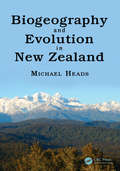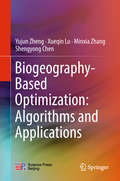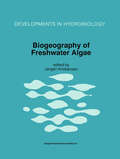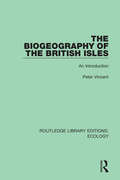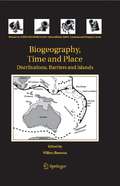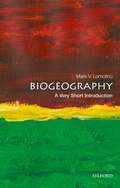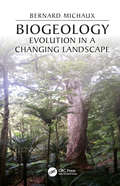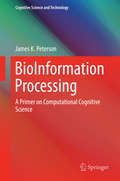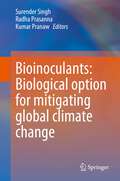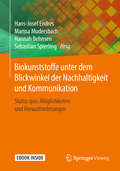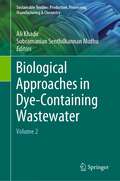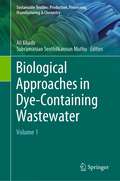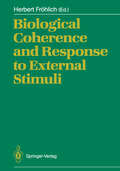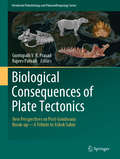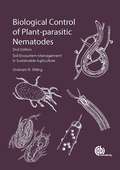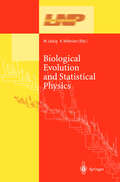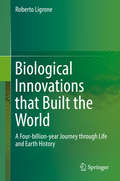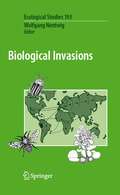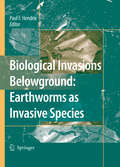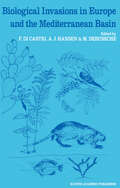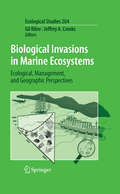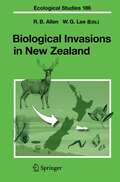- Table View
- List View
Biogeography and Evolution in New Zealand (CRC Biogeography Series)
by Michael HeadsBiogeography and Evolution in New Zealand provides the first in-depth treatment of the biogeography of New Zealand, a region that has been a place of long-enduring interest to ecologists, evolutionary scientists, geographers, geologists, and scientists in related disciplines. It serves as a key addition to the contemporary discussion on regionalization—how is New Zealand different from the rest of the world? With what other areas does it share its geology, history, and biota? Do new molecular phylogenies show that New Zealand may be seen as a biological ‘parallel universe’ within global evolution?
Biogeography and Evolution in New Zealand (CRC Biogeography Series #1)
by Michael HeadsBiogeography and Evolution in New Zealand provides the first in-depth treatment of the biogeography of New Zealand, a region that has been a place of long-enduring interest to ecologists, evolutionary scientists, geographers, geologists, and scientists in related disciplines. It serves as a key addition to the contemporary discussion on regionalization—how is New Zealand different from the rest of the world? With what other areas does it share its geology, history, and biota? Do new molecular phylogenies show that New Zealand may be seen as a biological ‘parallel universe’ within global evolution?
Biogeography-Based Optimization: Algorithms and Applications
by Yujun Zheng Xueqin Lu Minxia Zhang Shengyong ChenThis book introduces readers to the background, general framework, main operators, and other basic characteristics of biogeography-based optimization (BBO), which is an emerging branch of bio-inspired computation. In particular, the book presents the authors’ recent work on improved variants of BBO, hybridization of BBO with other algorithms, and the application of BBO to a variety of domains including transportation, image processing, and neural network learning. The content will help to advance research into and application of not only BBO but also the whole field of bio-inspired computation. The algorithms and applications are organized in a step-by-step manner and clearly described with the help of pseudo-codes and flowcharts. The readers will learn not only the basic concepts of BBO but also how to apply and adapt the algorithms to the engineering optimization problems they actually encounter.
Biogeography of Freshwater Algae (Developments in Hydrobiology #118)
by Jørgen KristiansenThis book is based on a workshop on biogeography of freshwater algae held during the Fifth International Phycological Congress in China 1994. A group of outstanding specialists covering widely different approaches to the subject have been brought together, and this collection of their contributions forms a unique volume: there is no other book on the subject. It thus fills an evident gap in the phycological literature, and will be of major interest to researchers and teachers within phycology, limnology, and evolutionary biology. However, it may also be useful in courses for advanced students.
The Biogeography of the British Isles: An Introduction (Routledge Library Editions: Ecology #17)
by Peter VincentOriginally published in 1990, The Biogeography of the British Isles is devoted to the biogeography of the British Isles and surrounding shelf seas. Bringing together a wealth of diverse information, it is thoroughly referenced and well illustrated, and will be invaluable to students of geography, environmental science, ecology, botany, and zoology. The book traces the development of British biogeography over the last two centuries, examining key topics such as ecosystems, habitats, and niches in the context of plant and animal distribution. The book gives a detailed account of the development of biogeographical mapping and recording systems, and describes modern-day distributions, both in the countryside and in urban areas against the backcloth of human activities.
The Biogeography of the British Isles: An Introduction (Routledge Library Editions: Ecology #17)
by Peter VincentOriginally published in 1990, The Biogeography of the British Isles is devoted to the biogeography of the British Isles and surrounding shelf seas. Bringing together a wealth of diverse information, it is thoroughly referenced and well illustrated, and will be invaluable to students of geography, environmental science, ecology, botany, and zoology. The book traces the development of British biogeography over the last two centuries, examining key topics such as ecosystems, habitats, and niches in the context of plant and animal distribution. The book gives a detailed account of the development of biogeographical mapping and recording systems, and describes modern-day distributions, both in the countryside and in urban areas against the backcloth of human activities.
Biogeography, Time and Place: Distributions, Barriers and Islands (Topics in Geobiology #29)
by Willem RenemaThis book offers exchanges between the fields of paleontology and zoology as patterns of biodiversity have long attracted the attention of both biologists and paleontologists. It covers the development of isolated island faunas, paleogeography and zoomorphology. The book shows that patterns are not always what they seem if looked at without a spatial or temporal reference.
Biogeography: A Very Short Introduction (Very Short Introductions)
by Mark V. LomolinoBiogeography is the study of geographic variation in all characteristics of life - ranging from genetic, morphological and behavioural variation among regional populations of a species, to geographic trends in diversity of entire communities across our planet's sufrace. From the ancient hunters and gatherers to the earliest naturalists, Charles Darwin, Alfred Russel Wallace, and scientists today, the search for patterns in life has provided insights that proved invaluable for understanding the natural world. And many, if not most, of the compelling kaleidoscope of patterns in biological diversity make little sense unless placed in an explicit geographic context. The Very Short Introduction explains the historical development of the field of biogeography, its fundamental tenets, principles and tools, and the invaluable insights it provides for understanding the diversity of life in the natural world. As Mark Lomolino shows, key questions such as where species occur, how they vary from place to place, where their ancestors occurred, and how they spread across the globe, are essential for us to develop effective strategies for conserving the great menagerie of life across our planet. ABOUT THE SERIES: The Very Short Introductions series from Oxford University Press contains hundreds of titles in almost every subject area. These pocket-sized books are the perfect way to get ahead in a new subject quickly. Our expert authors combine facts, analysis, perspective, new ideas, and enthusiasm to make interesting and challenging topics highly readable.
Biogeology: Evolution in a Changing Landscape (CRC Biogeography Series)
by Bernard MichauxThis detailed exposition gives background and context to how modern biogeography has got to where it is now. For biogeographers and other researchers interested in biodiversity and the evolution of life on islands, Biogeology: Evolution in a Changing Landscape provides an overview of a large swathe of the globe encompassing Wallacea and the western Pacific. The book contains the full text of the original article explored in each chapter, presented as it appeared on publication. Key features: Holistic treatment, collecting together a series of important biogeographical papers into a single volume Authored by an expert who has spent nearly three decades actively involved in biogeography Describes and interprets a region of exceptional biodiversity and extreme endemism The only book to provide an integrated treatment of Wallacea, Melanesia, New Zealand, the New Zealand Subantarctic Islands and Antarctica Offers a critique of fashionable neo-dispersalist arguments, showing how these still suffer from the same weaknesses of the original Darwinian formulation. The chapters also include analysis of many major theoretical and philosophical issues of modern biogeographic theory, so that those interested in a more philosophical approach will find the book stimulating and thought-provoking.
Biogeology: Evolution in a Changing Landscape (CRC Biogeography Series)
by Bernard MichauxThis detailed exposition gives background and context to how modern biogeography has got to where it is now. For biogeographers and other researchers interested in biodiversity and the evolution of life on islands, Biogeology: Evolution in a Changing Landscape provides an overview of a large swathe of the globe encompassing Wallacea and the western Pacific. The book contains the full text of the original article explored in each chapter, presented as it appeared on publication. Key features: Holistic treatment, collecting together a series of important biogeographical papers into a single volume Authored by an expert who has spent nearly three decades actively involved in biogeography Describes and interprets a region of exceptional biodiversity and extreme endemism The only book to provide an integrated treatment of Wallacea, Melanesia, New Zealand, the New Zealand Subantarctic Islands and Antarctica Offers a critique of fashionable neo-dispersalist arguments, showing how these still suffer from the same weaknesses of the original Darwinian formulation. The chapters also include analysis of many major theoretical and philosophical issues of modern biogeographic theory, so that those interested in a more philosophical approach will find the book stimulating and thought-provoking.
BioInformation Processing: A Primer on Computational Cognitive Science (Cognitive Science and Technology)
by James K. PetersonThis book shows how mathematics, computer science and science can be usefully and seamlessly intertwined. It begins with a general model of cognitive processes in a network of computational nodes, such as neurons, using a variety of tools from mathematics, computational science and neurobiology. It then moves on to solve the diffusion model from a low-level random walk point of view. It also demonstrates how this idea can be used in a new approach to solving the cable equation, in order to better understand the neural computation approximations. It introduces specialized data for emotional content, which allows a brain model to be built using MatLab tools, and also highlights a simple model of cognitive dysfunction.
Bioinoculants: Biological Option for Mitigating global Climate Change
by Surender Singh Radha Prasanna Kumar PranawThis edited book covers various bioinoculants for sustainable crop production under the changing global climate. The book envisages a compilation of articles relevant to the current status of production and use of novel microbial inoculants for different crops and highlights their role in mitigating global climate challenges. These include nutrient deficiencies, salinity, drought, and emerging pathogens. In addition, success stories and commercialization aspects are also discussed. Growing environmental concerns related to climate change can potentially decrease the global yield capacity of agricultural systems. Agricultural productivity is severely affected by major biotic and abiotic factors. The phytomicrobiome plays a critical role in the survival of the holobiont, particularly for plants growing in extreme environments. The use of microbial-based agricultural inputs has a long history, beginning with a broad-scale rhizobial inoculation of legumes in the early twentieth century. Microbial inoculants are considered one of the best and most effective strategies for sustainable agriculture under climate change, and a viable solution to meet the twin challenges of global food security and environmental sustainability. It is therefore imperative to understand the current status and development in the area of bioinoculants from a global perspective. The chapter’s focus would be on major agro-ecologies, covering all major crops across the globe, along with the commercialization status of different bioinoculants in different countries The book caters to the needs of the students, faculty, policymakers, and researchers working in the area of microbiology, biotechnology, environmental sciences, and botany.
Biokunststoffe unter dem Blickwinkel der Nachhaltigkeit und Kommunikation: Status quo, Möglichkeiten und Herausforderungen
by Hans-Josef Endres Marina Mudersbach Hannah Behnsen Sebastian SpierlingDas Buch zeigt, wie eine Nachhaltigkeitsbewertung von Biokunststoffen gelingen kann und wie die Ergebnisse einer solchen Bewertung ausfallen. Es analysiert die öffentliche Wahrnehmung beim Verbraucher sowie die politischen Rahmenbedingungen von Biokunststoffen.
Biological Approaches in Dye-Containing Wastewater: Volume 2 (Sustainable Textiles: Production, Processing, Manufacturing & Chemistry)
by Ali Khadir Subramanian Senthilkannan MuthuThis Volume 2 contains essential contributions highlighting the use of biotechnology in dye removal. It begins with an overview of activated sludge process for dye removal along with its limitation is carried out and describes the fundamental concepts of dye-containing textile wastewater treatments, particularly microbial and enzymatic approaches, including the most usual textile wastewater treatments and their trends. It discusses the role microbial biofilms play when employed in the integrated treatment system for effective detoxification, degradation and complete mineralization of pollutants in dye waste effluents. It assesses the most recent advances in the biotransformation of synthetic dyes from wastewater, especially anthraquinone-typed dyes. Phycoremediation as an emerging and efficient technology in dye removal, remediation strategies used by microalgae, and the role of fungi in the dye removal are presented.
Biological Approaches in Dye-Containing Wastewater: Volume 1 (Sustainable Textiles: Production, Processing, Manufacturing & Chemistry)
by Ali Khadir Subramanian Senthilkannan MuthuThe textile industry segment has been continuously expanding and it is reported that the global market was US$1000 billion in 2020. Aside from the fact that textile industry could be profitable and offers several advantages for human life, this industry produces wastewater containing many harmful substances in the form of organic and inorganic moieties. Textile wastewater can lead to serious environmental problems if discharged without treatment. In this first volume of the application of biological mechanisms, processes and units are reviewed in terms of dye degradation and removal. The role of biodegradation, bioaccumulation and biosorption in bio-decolorization are discussed. The book starts with highlighting the fundamentals of aerobic and anaerobic mechanisms having different configurations. The moving bed bioreactor (MBBR), up-flow anaerobic sludge blanket reactors, sequential aerobic/anaerobic batch reactors, membrane bioreactor, etc are also covered in this edition.
Biological Consequences of Plate Tectonics: New Perspectives on Post-Gondwana Break-up–A Tribute to Ashok Sahni (Vertebrate Paleobiology and Paleoanthropology)
by Guntupalli V. R. Prasad Rajeev PatnaikThis book recognizes and celebrates the contributions of Professor Ashok Sahni to the field of paleontology. Prof. Sahni established a School of Vertebrate Palaeontology at Panjab University, Chandigarh, India, where he trained many of today’s vertebrate paleontologists of India. The book covers topics on evolutionary patterns, macroevolutionary events, origination and radiation events, changes in physical environments & climate and their implications for biodiversity dynamics, intercontinental affinities and biogeographic connections in a plate tectonic framework. The book begins by exploring India in the age of the dinosaurs, discussing new fossil remains from the Jurassic Era, then moves through the Cretaceous and Eocene to provide a picture on faunal and floral changes in Gondwanaland in the context of plate tectonics. Furthermore, the book explores the evolutionary patterns and biotic dispersals that resulted from the northward drift of Indian plate during the Cretaceous and its collision with Asia in the Eocene. The respective chapters reveal the role of plate tectonics and climate in shaping the geographical distribution of plants and animals in Gondwana, specifically in India, as well as the post-India/Asia collision implications for biodiversity changes and biogeography in the region’s continental environments. Given its scope, the book will appeal to vertebrate paleontologists, evolutionary biologists, and paleobiogeographers.
Biological Control of Plant-parasitic Nematodes: Soil Ecosystem Management in Sustainable Agriculture
by Graham StirlingPlant-parasitic nematodes are one of multiple causes of soil-related sub-optimal crop performance. This book integrates soil health and sustainable agriculture with nematode ecology and suppressive services provided by the soil food web to provide holistic solutions. Biological control is an important component of all nematode management programmes, and with a particular focus on integrated soil biology management, this book describes tools available to farmers to enhance the activity of natural enemies, and utilize soil biological processes to reduce losses from nematodes.
Biological Evolution and Statistical Physics (Lecture Notes in Physics #585)
by M. Lässig A. VallerianiThis set of lecture notes gives a first coherent account of a novel aspect of the living world that can be called biological information. The book presents both a pedagogical and state-of-the art roadmap of this rapidly evolving area and covers the whole field, from information which is encoded in the molecular genetic code to the description of large-scale evolution of complex species networks. The book will prove useful for all those who work at the interface of biology, physics and information science.
Biological Innovations that Built the World: A Four-billion-year Journey through Life and Earth History
by Roberto LigroneThe book is a detailed account of major biological events that contributed to create the present world and our species, with emphasis on cause-effect interrelationships and environmental impact. Its main goal is to guide the reader toward an understanding of the continuity of life across diversity, and of its large-scale interactions with the planet. Combining scientific soundness with a constant effort for clarity, the book begins with a cloud of dust in a corner of the Galaxy and, covering an immense lapse of time, terminates with an organism that ponders about the texture of the Universe. Comprehensive, updated references added to each chapter will help the reader wishing to expand any of the topics. A glossary explains less common technical terms.
Biological Invasions (Ecological Studies #193)
by Wolfgang NentwigThis new volume on Biological Invasions deals with both plants and animals, differing from previous books by extending from the level of individual species to an ecosystem and global level. Topics of highest societal relevance, such as the impact of genetically modified organisms, are interlinked with more conventional ecological aspects, including biodiversity. The combination of these approaches is new and makes compelling reading for researchers and environmentalists.
Biological Invasions Belowground: Earthworms as Invasive Species
by Paul F. HendrixThe papers in this book are based on efforts by an international group of soil ecologists to assess the biological and ecological mechanisms of earthworm invasions. They examine their geographic extent and impacts on terrestrial ecosystems, and possible means by which earthworm invasions might be mitigated. The book broadens the discussion on invasion biology and ecology to belowground systems.
Biological Invasions in Europe and the Mediterranean Basin (Monographiae Biologicae #65)
by F. Di Castri A. J. Hansen M. DebusscheIn view of the massive change in the area of distribution of many world biota across classical biogeographical realms, and of the drastic restructuring of the biotic components of numerous ecosystems, the Scientific Committee on Problems of the Environment (SCOPE) decided at its general Assembly in Ottawa, Canada, in 1982 to launch a project on the 'Ecology of Biological Invasions'. Several regional meetings were subsequently organized within the framework of SCOPE, in order to single out the peculiarities of the invasions that took place in each region, the behaviour of their invasive species and the invasibility of their ecosystems. Most noteworthy among such workshops were one in Australia in August 1984, one concerning North America and Hawaii in October 1984, and one dealing with southern Africa in November 1985. A leitmotiv of these workshops was that most of the invasive species to those regions were emanating from Europe and the Mediterranean Basin, inadvertently or intentionally introduced by man. It was therefore considered as a timely endeavour to organize the next regional meeting in relation to this region. The workshop on 'Biological Invasions in Europe and the Mediterranean Basin' was held in Montpellier, France, 21 to 23 May 1986, thanks to the financial support of SCOPE and of the A.W. Mellon Foundation, and the logistic facilities of the Centre National de la Recherche Scientifique (C.N .R.S.).
Biological Invasions in Marine Ecosystems: Ecological, Management, and Geographic Perspectives (Ecological Studies #204)
by Gil Rilov Jeffrey A. CrooksBiological invasions are considered to be one of the greatest threats to the integrity of most ecosystems on earth. This volume explores the current state of marine bioinvasions, which have been growing at an exponential rate over recent decades. Focusing on the ecological aspects of biological invasions, it elucidates the different stages of an invasion process, starting with uptake and transport, through inoculation, establishment and finally integration into new ecosystems. Basic ecological concepts - all in the context of bioinvasions - are covered, such as propagule pressure, species interactions, phenotypic plasticity, and the importance of biodiversity. The authors approach bioinvasions as hazards to the integrity of natural communities, but also as a tool for better understanding fundamental ecological processes. Important aspects of managing marine bioinvasions are also discussed, as are many informative case studies from around the world.
Biological Invasions in New Zealand (Ecological Studies #186)
by Robert B. Allen William G. LeeHuman colonization of New Zealand has dramatically altered the resident biota, introduced numerous alien organisms to these once remote islands, and exported local species to the world. This book reviews invasions, investigates what controls the success of invaders and studies the consequences for ecosystems both on land and offshore. The book tests current theories about the success of invaders and evaluates principles for effective management of biological invasions worldwide.
